Automatics: What Action Type for Me?
By Stephen Camp
Perhaps more today than ever before the prospective handgun buyer can be bedazzled by the array of semiautomatic pistols available, and for some these seemingly infinite choices can be confusing. Assuming that our buyer has waded through the endless debates on "stopping power" and had decided on caliber, he or she still has to decide not only on brand, but action type. Sometimes the brand will dictate this; sometimes not. What should he or she get: Single-Action, DA/SA, DAO, "Selective DA", Safe Action, or DAK? For the more seasoned members of the handgunning community, this may not be a problem, but for those just starting out, the same is probably not true. It gets a little more confusing with other options such as exposed hammers vs. striker-fired or the merits for and against spur hammers vs. ring, etc.
Let's take a look at the different categories of semiautomatic pistols available today and visit both their general characteristics as well as perceived good and not so good points. I will do my best to provide objective answers but will also add my own personal observations based on shooting and using each type action. I ask the reader to decide which questions concerning each action type are most important to him. Forget the "everybody knows" this or that is "best." Decide on those factors most important to you. Does this mean that if you do this you're sure to buy just that perfect pistol? Nope, but I think you stand a better chance. This is also why I'm including my personal long-term observations on the different action types as a shooter. The way a handgun is described and its actual shooting characteristics may not be one and the same.
Single-Action: Though some of the early automatics were striker-fired rather than having a separate hammer and firing pin, those with the exposed hammer were almost always single-action. In other words, the trigger performed one function; it dropped the hammer and fired the pistol. Before any shot could be fired, the hammer had to be manually cocked. This could occur by thumbing back the hammer when a live round was already chambered or when retracting and releasing the slide to chamber a round from the magazine.
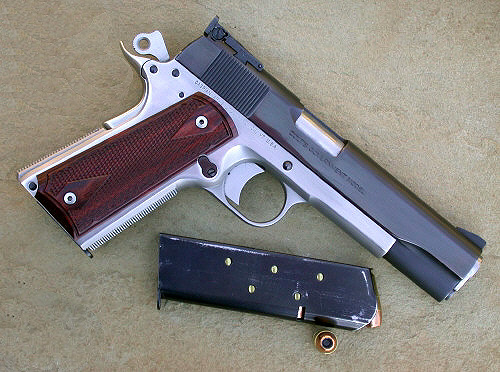
This 1911 pattern pistol is a prime example of the single-action semiautomatic handgun. The hammer must be cocked manually before the first shot can be fired. After that it is self-cocking. This type action provides for a constant trigger pull from the first to the last shot. With the 1911 it is possible to obtain very light and very crisp trigger pulls. It also has an extremely short reset.
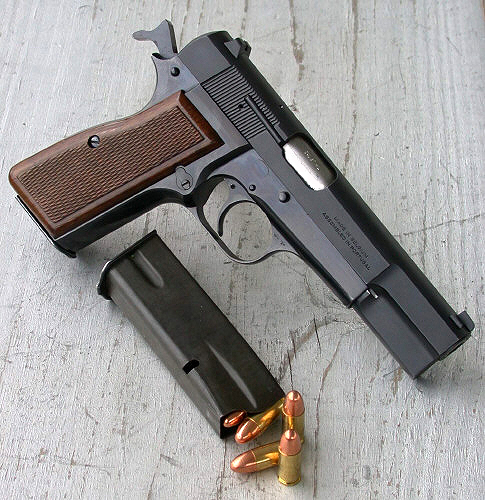
The Hi Power, also known as the P35 to many, is another classic example of the single-action automatic. In original trim, its trigger also only drops the hammer. Because of the shape of its trigger some folks mistakenly believe that it is a double-action pistol though it most certainly is not.
The single-action autopistol remains a favorite with "old" shooters who teethed on it in their beginning days as well as some newer members of the handgunning community. The reason is simple; its design allows for most easily getting accurate hits, be the target paper or something else. The single-action trigger pull can be lighter than any other type. Thus, less pressure is required to fire the shot. This means that it is easier to maintain proper sight alignment when the shot is fired. Particularly with the 1911-type pistol, subsequent shots can be made with extreme speed due to the super-short reset. In other words, the trigger finger doesn't have to let the trigger move forward but a small fraction of an inch before the pistol is ready to fire again.
The traditional type single-action automatic most popular today is without question Mr. Browning's 1911 in one form or another but another is steadily gaining ground. That would be Springfield Armory's XD series. Though striker-fired, the trigger performs but one function. It releases the spring-loaded striker from a fully retracted position to fire the gun, which exactly parallels the traditional single-action's hammer being dropped from full-cock to strike the firing pin. Heckler & Koch's P7 series of handguns can be considered unique among single-actions autos. While they are striker-fired, the striker is safely at rest until the pistol is gripped tightly enough for the "squeeze cocker" on the front strap to retract it. Like all single-actions, the trigger does nothing other than to release the hammer or striker.
In my opinion, the single-action automatic remains the best choice for shooting accurately in both slow and rapid-fire, but does that make it the top choice for all people and all situations? The single-action automatic in 1911 form is often the pick of the litter for such "high speed/low drag" groups as the FBI Hostage Rescue Team, Delta, as well as other specialized military and police groups. Does that mean that the single-action auto is simply the best choice, period? In my opinion, the answer is no. Let's look at that for a few minutes.
The attributes making the single-action automatic especially the 1911-pattern pistol easy to shoot straight and fast in trained hands are a very light trigger pull that is both short and quick to reset. These very same characteristics can work against it, making it more "dangerous" than other action-types. I use "dangerous" in quotes because I believe that while the gun is mechanically safe and a century of use proves that up, when we put the human being into the mix things can change. The single-action auto is very intolerant of incompetent gun handling. A finger on the trigger in a time of stress with the manual safety disengaged, either inadvertently or on purpose, can very easily lead to a negligent discharge. The easier a pistol is to fire, the more care there must be in its being handled properly. Safe gun handling is not an option with the single-action automatic. While this is true with any firearm, inept handling will probably show up sooner with the single-action…sometimes with tragic results.
The (false) perception that a cocked-and-locked single-action auto is unquestionably unsafe is one reason why we do not see more single-action automatics in police and military holsters. Assuming good mechanical condition, the single-action automatic is simply not going to fire unless the safeties are disengaged and the trigger pressed. The problem arises in the short and light trigger's being pressed when not intended. We see this when users who have not learned safe gun handling to the degree that it is second nature. In an absent-minded moment or when in a panic situation, the finger finds its way to the trigger with the safety in the off position.
But, there can be other problems as well and they stem from the fear of "cocked-and-locked" or "Condition One" carry. They are "Condition Two" and "Condition Three" for the single-action auto.
Condition Two describes a single-action autoloader having a chambered round and loaded magazine but with the hammer resting all the way forward against the rear of the firing pin. This is a safe enough condition assuming that the pistol has an inertial firing pin or internal firing pin lock. In this condition, the hammer must be manually brought to full-cock before the pistol can be fired. This is a two-fold problem as I see it. First, lowering the hammer by hand while pressing the trigger can result in the pistol being negligently fired if handler's thumb or fingers slip. That said, I've known more than a few old-time peace officers that managed this relatively simple task with no problems but the potential remains. To get the gun to fire in an emergency situation while under stress can also lead to obvious problems and it is slower than merely disengaging a thumb safety and pressing the trigger to fire.
Condition Three describes a single-action automatic with only the magazine loaded. To get the pistol into firing mode, the slide is retracted and released. If the pistol is not being immediately used in a deadly force scenario, the thumb safety should be engaged. In other words, the gun goes to Condition One. Why not just begin there? A question often asked is whether or not the mainspring is weakened by continually leaving the hammer cocked. The answer is simply no. In a quality spring such as those from the major gun makers, there is no weakening from this. What weakens springs is use. Compressions when the hammer is cocked and decompressions when the hammer springs forward are what weaken springs. Another assumption implicit to Condition Three carry is that the user will always have both hands free when it comes time to activate the pistol. Obviously, this may not be true.
The best case that can be made for this mode of carry is that if the magazine in the pistol is the only one readily available, the gun can be rendered incapable of firing by simply removing and pocketing the magazine. I am not a fan of Condition Three primarily because of its requiring two hands to ready the gun in an unforeseen situation.
Conventional Double-Action: As most will already know, these pistols require a long initial trigger pull to both cock and release the hammer with subsequent shots being fired single-action. This is the type action that Col. Cooper (and others) held in low esteem. I believe that he once referred to it as "the badge of the incompetent." Though I respected Jeff Cooper quite a lot, I do disagree with that last statement but do agree that there definitely is a difference between the first DA shot and the SA shots that follow. At the same time and depending upon the pistol I have not found that transition to be as great as I had initially expected. I believe that this will differ from person to person, but an experienced shooter can probably shoot a DA/SA conventional automatic very well if he finds the right one. Just as felt recoil and beauty are subjective entities, so I think it may be with the conventional double-action's different trigger pulls for double and single-action shots.
I do not believe that firing this type pistol in double-action consistently results in more easily made precise shots as with the light crisp single-action automatic's trigger pull. At the same time I do not believe that one is doomed to having to "throw away the first double-action shot" as some have recommended. With certain conventional double-action pistols, I might not get an "X" with the heavier DA pull but neither will it have to be a miss or near miss. On an IDPA type target that is shot with a balance of both speed and coarser accuracy than slow-fire bullseye shooting, the practiced double-action auto shooter gives up very little if anything in my observations of both experienced police shooters as well as the beginners.
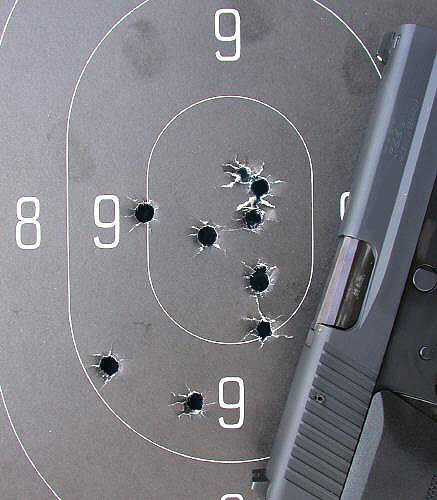
Each of these shots was fired with a SIG-Sauer P220, a conventional DA/SA automatic, and were fired using double-action only. Distance was 15 yards. Now, this will not win any prizes at Camp Perry, but if required to shoot double-action with a quality autoloader, one is not so immediately damned to failure as some might expect…or proclaim. To me it is more difficult to get a tight group or hit a smaller target using double-action in the auto, but there could be other factors to consider than how easily an automatic lends itself to precise target work.

At 10 yards, I performed several "Failure to Stop" drills. Starting from a low ready, I brought the gun to eye level and fired the first shot double-action at the chest. As fast as I could obtain a "flash sight picture" a second shot was fired single-action. A third shot was fired at the head in the single-action mode. While neither this target nor myself are any threat to accomplished IPSC shooters, I think it does show that emergency work can be done with the conventional double-action automatic. If one wants to merely shoot as small a group as he can, the pistol can be thumb-cocked and all shots fired single-action. The same could hold true for the policeman's "rescue shot" fired from concealment if his DA/SA sidearm was all that he had and the shot had to be made. While the manual of arms for the conventional DA/SA auto is necessarily a bit longer than for the single-action, it is not like trying to learn multivariable calculus; it just requires study and the will to practice it. I think that it is a true statement that people not willing to put forth the amount of effort required to at least be competent with a firearm shouldn't count on one for anything more than slow-fire at paper targets…if that!
I know that it is not recommended, but on the relatively rare occasion I simply carry an automatic stuck in my waistband without a holster, I prefer double-action to a cocked-and-locked single-action autopistol.
One advantage that I see to the conventional DA/SA automatic is that usually they have some sort of decocking lever. Sometimes it is incorporated into the thumb safety and sometimes not, but the hammer never has to be lowered by easing the hammer down by pressing the trigger. I have no problem with people easing the hammer forward while using the decocker but consider it unnecessarily foolhardy if the decocking system is not used at all!
Many years ago, I "tested" myself on the difficulty in using the conventional double-action auto compared to the single-action. The pistols used were a Walther P38 for the double-action and a Colt Gov't Model for the single. There was a noticeable difference. About 15 years ago, I repeated this comparison with the same Gov't Model but using a CZ-75 and SIG-Sauer P220 for the double-actions. The difference was marked. Neither of these pistols is as muzzle light as the P38, but I think that the main difference was in the double-actions themselves. The CZ's was light and smooth but longer. The SIG-Sauer's was a little heavier but shorter. In any event, I found it much easier to shoot well in double-action with these two pistols and was surprised at the pleasing results.
For me, a disadvantage of the conventional DA/SA automatic is the exterior thumb safety. Though not all have them, many do and they are awkwardly mounted on the slide and operate in just the opposite directions of the single-action's; i.e. up is to fire and down is safe. Some of these merely act as decockers and are spring-loaded to return to the fire position when released.
There is some debate on whether or not to carry the conventional DA/SA with the safety on or off…if there is a choice. Arguments can be made for either side, but unless the safety is frame-mounted with down for fire and up for safe, I do not engage the safety if carrying such a pistol. Others may feel just the opposite and I have no issue either way other than to strongly suggest that one be proficient enough to disengage the awkward safety quickly and without having to fumble or think about what to do if the firearm is immediately needed.
Selective Double-Action: This term refers to those automatics capable of both double and single-action fire having an external safety that does not drop the hammer. In other words, it doesn't double as a decocking lever. One of these would be the CZ-75 and many of its variants although some are available with decocking levers. Another would be the Taurus PT-92 and 99. These are capable of double-action for the first shot and single-action shots thereafter, but they can also be carried with the hammer fully cocked and the thumb safety engaged. They are usually frame-mounted rather than being on the slide. (The Star Model 28 is a selective DA/SA pistol, but has a slide-mounted thumb safety.) Newer versions of these guns have thumb safeties that when depressed past the fire position, decock the pistol. I have noticed that these guns seem popular with single-action auto fans who just happen to like the DA/SA pistol in question but don't care for DA. They can treat it like a single-action auto.
I do favor some pistols that happen to be of this type. It is more for the gun's mechanical accuracy or feel than having selective double-action. I don't really buy into the "second strike capability" touted by some, much preferring to simply clear the chamber and replace with the next round from the magazine. (This can be done quickly with practice.) With quality ammunition, it is not likely that a round won't fire when hit by the firing pin; it could happen, but it is the exception rather than the rule.
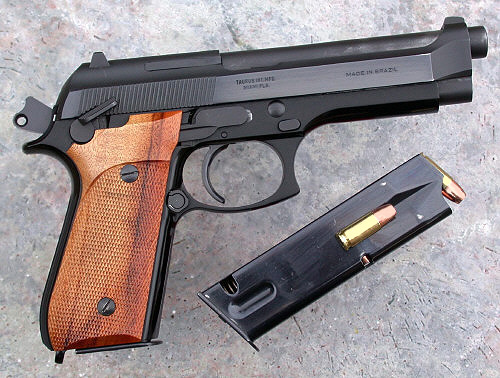
This Taurus PT-92 is an example of a selective double-action automatic. Here it is seen cocked-and-locked ala the 1911 or Hi Power. This particular make and model allows for the hammer to also be lowered for a double-action first shot if required or mandated by policy. The Taurus' frame-mounted thumb safety is very comfortable and "natural" to use and can be engaged with the hammer fully forward. That allows for a double-action first shot requirement but with easy-to-off thumb safety engagement for people concerned with weapon retention.
Some have opined that the selective double-action autopistol is more dangerous than the conventional because it offers more carry variations. True enough, they can be carried with the hammer cocked and thumb safety engaged or hammer down and safety engaged in some models. Others will not allow the thumb safety to be engaged with the hammer forward. I agree that where more variations exist, more confusion can result, but add that the average person who is sharp enough to go by the rules of safe firearm handling and possessing at least average intelligence and the will to learn his firearm, can master this.
I see the selective double-action automatic as a nice compromise pistol for the fellow who likes to shoot targets at the range but is uncomfortable with Condition One for concealed carry or has concerns about leaving a "cocked gun" in the house for home protection.
A downside that I see for most double-action pistols, be they conventional or selective, is that they are more internally complex. As a general rule, they have more small parts and springs than does the single-action automatic. They are therefore more difficult to detail-strip for major cleaning or part replacement. Also, Mr. Murphy never sleeps and it seems logical that where there is more complexity, there is a greater potential for something to go wrong. Having said that, I have not seen very many problems with non-single-action autos in 11 years as a police firearm instructor.
If being able to easily disassemble an automatic to its last part is a major concern, the double-action in any version is going to be less easy than the 1911 or P-35.
Double-Action-Only: These weapons are usually touted as having the same consistent trigger pull first shot to last. I think a more accurate description for some is "the same heavy trigger pull first shot to last." The DAO automatic allows only for double-action shooting and from my own shooting of these, some are almost impossible to shoot well due to gritty, heavy trigger pulls that often add stacking at the end of the pull as a "bonus." I used to rail against DAO but have tempered in more recent years, having seen some DAO pistols that were quite useable. Frankly, with the exception of a couple of types of DAO that I'll mention later, I do not favor the concept at all. If the rules were that I had to carry certain DAO semiautomatics or a DA revolver, I'd go with the latter.
Many DAO pistols do not offer any external thumb safeties, as they are not needed unless one has concerns about losing the pistol to an aggressor in a struggle. Their strong point is that to fire, one simply pulls the trigger. The downside is that on some examples the DAO pull is heavy and poor enough to severely inhibit accurate shooting.
Two DAO systems that I have tried and find imminently useable are the DAK from SIG-Sauer and what Glock calls "Safe Action." Let's take a look at these.
DAK: The initials stand for "Double-Action-Kellerman" in honor of the man who came up with the idea. When the trigger is pressed on the DAK-equipped pistol, the hammer is cocked via a "leg" on the hammer that extends the distance between where the force is applied and the pivot hole of the hammer. This results in a much lighter trigger pull due to improved leverage. The DAK pull on a SIG P229 I measured is just over 6.5 pounds. While reset is nowhere near as short as the single-action 1911, it is not bad at all for real world use. In practiced hands, there is a shorter reset available. This results in a slightly heavier pull, but a shorter one. I am still learning this system and cannot use the shorter reset point with any kind of speed; I'm sure others can.
Though new compared to the conventional or selective double-action and certainly the single-action auto, the DAK system does seem to work. The Texas Department of Public Safety has used it for several years now; it seems to be easy enough for troopers to get the hits with and I'm finding no reports of chronic frailties within the system.
Speaking for myself, were I going to an auto strictly for protection and couldn't use a single-action automatic for whatever reason, at this point I'd cast my lot with SIG-Sauer's DAK pistols.
At this point in time, my only first-hand experience has been with a P229R in 9mm and a P220 SAS (SIG Anti-Snag) in .45 ACP. To say that I have been pleasantly surprised is an understatement. Though I favor the single-stack P220 in .45 ACP, the double-stack P229 in 9mm does have a smoother action, not by much but it is there. I have read that the double-stack guns generally do have smoother DAK actions but I am not sure that I understand why…not at this point anyway. What I do know is that if a person can shoot a double-action revolver accurately, he should be able to do the same with the DAK. Yes, they are that good in my opinion.
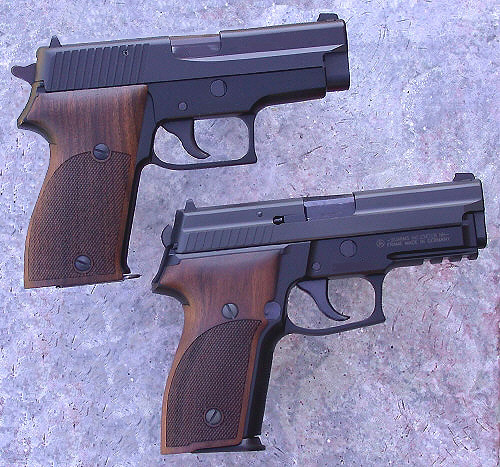
Shown (top) is the SIG-Sauer P225, a conventional DA/SA autoloader and the P229R with DAK. The double-action on the DAK-equipped pistol is MUCH easier to use than on the P225. I like both pistols to be sure, but if forced to choose only one of these two, it would be the DAK.
While ParaOrdinance offers an enhanced DA on their 1911 type pistols, I do not have much hands-on experience with these guns. I do know that the trigger pulls on the ones I tried were extremely light. Unlike the true single-action 1911 pistol, the Para equipped with the LDA (Light Double-Action) does allow the thumb safety to be engaged with the hammer down. I have no long-term experience with these pistols and don't know how well they may…or may not hold up. It is my understanding that they are pretty complex internally. This would make detail stripping more difficult, but by how much I do not know. Neither do I have any experience with HK's LEM double-action system.
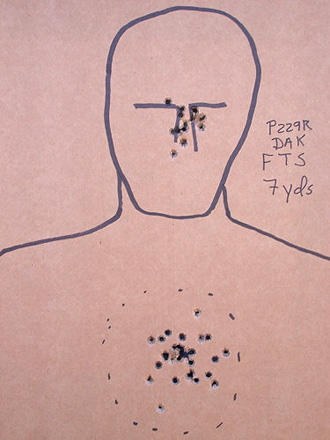
Using the P229R with DAK, I fired several FTS (Failure to Stop) exercises. They were very easy to do. I would not feel "handicapped" if required to use a DAK-equipped SIG-Sauer for serious purposes. Given a choice, I'll stick with my tried-and-true single-actions, but the DAK would definitely be my second choice and for a shared house gun, I see it as a real winner when different shooters with differing degrees of competence might have to use the pistol.
Glock Safe Action: This is a term used by the company to describe what is essentially an assisted DAO automatic. In other words, pressing the trigger retracts the spring-loaded striker and then releases it. When the slide is cycled to chamber the initial cartridge or in firing, the striker is about 40% "cocked". Pressing the trigger results in a lighter trigger pull.
The Glock line of handguns is extremely popular with some users and held in contempt by others. These pistols seem to polarize pistoleros pretty strongly. Let's try and take a look at them and examine both strong and not so strong points as objectively as we can.
Up front, let me say that these are not my favorite handguns. Let me add that at least in 9mm, I've found them to be utterly reliable, long-lived, and very easy to carry. At distances much beyond 25 yards, I find them more difficult to shoot quite as accurately as most other handguns and especially a tuned single-action automatic, but at closer distances, they can be extremely quick, yielding scores indistinguishable than those from other pistols. I have seen a practiced Glocker spank some "1911 guys" in competitions and a person determined to learn the Glock is very likely to be capable of better shooting than me.
So why do so many disparage the Glock and why is it even germane to a discussion of action type? I think the reason is that a prospective buyer for whom the Glock might be just the thing might never try one if he believes all the negative comments without looking at the "why" of it all. I do not claim to have the definitive answers, but may have some.
First, the Glock is a "plastic pistol". Some people simply prefer handguns of steel and wood; I know that I do. To me the Glock doesn't offer much in grace or artful lines but to others this is not relevant at all and yet others actually think they look good! (Beauty truly is in the eye of the beholder, as the old saying goes.)
To me, one of the main valid complaints is the Glock's grip angle. There is just too much of it for me. It seems too exaggerated. Could it be that to many others and myself the norm is the 1911 or Hi Power grip angle? I have noticed that most of these complaints have come from long-time 1911 shooters. One of Springfield's XD's strong points seems to be its "better" grip angle.
When using the Glock at speed, people who are used to more traditional automatics almost universally report that it doesn't point as well for them. Shooters transitioning from the double-action revolver don't seem to voice these concerns quite as much. I do not find the Glock's grip angle as natural as what I've shot for over 3 decades but neither have I found it impossible (or even close to it) to learn. It took several weeks of daily practice, but was pretty easily done. Though others have reported that when they use the Glock regularly their other handguns then don't point right, I have not found that to be the case. I cannot say if it would be true or not for a specific person.
To me, the biggest concern with the Glock is not the dreaded "kaboom". (I've witnessed two in a Glock 22.) It is the nature of the "safe action" itself. In my opinion, here is where we find out if the Glock is or is not the gun for the individual prospective buyer. We find many concerns voiced over the safety of the Glock pistol in general.
Let's take a long hard look at this issue as objectively as possible.
Out of the box, the trigger pull for the standard Glock is rated at about 5.5 pounds. Other weights can be had, but this is usually the "normal" one. Some single-action automatics have trigger pulls in this range. The Glock's only external safety is mounted on the trigger and is deactivated when the trigger is placed on it. At this point we have a 5.5-pound trigger pull combined with a relatively short pull distance. This is good if we are preparing to shoot but can be disastrous otherwise. The Glock in non-disciplined hands might be considered akin to a cocked-and-locked single-action auto, finger on the trigger, and safety disengaged. A loud noise or about any surprise, particularly if in a deadly force situation, could spark needless tragedy.
I think it might be fair to say that the easier a pistol is to fire, the easier it can be to fire negligently.
Does this mean that the Glock is inherently unsafe? Not to me, but it does underscore the absolute need for safe firearm handling and discipline that is second nature. But a second's carelessness is plenty long enough for a negligent discharge to ruin more than one life, the shooter's and the victim's.
The tough-as-nails Glock combined with its usually superb reliability make it a pistol to be respected. It is certainly a very popular one. When great numbers of people buy the Glocks, it is only natural that we learn of more mishaps with them. That said, I do suspect that if we looked at percentages of unintentional discharges, the Glock would be right up near the top of the list. I do not see this as a fault of the design. I truly believe that the design's safety is less forgiving of improper handling than some other action types. It is my belief that in the vast majority of instances a Glock goes off unexpectedly, human error is the culprit.
If one favors the Glock, fine. These pistols can be loyal, trusted servants, but the user absolutely must practice safe gun handling. It must become second nature. This is true of all firearms, but in spades with the Glock. The pistol is very easy to use under stress due to its point-and-pull design but when coupled with the passive external safety and relatively short and light trigger pull, the human has got to be smarter than the gun!
One must also choose holsters for the pistol that do not have retaining straps, etc that could inadvertently get inside the gun's trigger guard when holstering. This can and has resulted in unexpected loud noises.
As with the single-action auto, the Glock is one that I much prefer not to just stick in my waistband. In fact, I will not carry a Glock unless it is holstered.
For the majority of us, I believe that the Glock possesses plenty of mechanical accuracy. In other words, it is capable of producing nice service gun sized groups. My problem with the Glock is that I have to work harder to get them than with either the single-action or DAK automatics. The Glock is a pretty light handgun due to its polymer frame. This is great for carry but less than ideal for precise shooting. Certainly this design was not intended to compete at formal bullseye matches but this doesn't mean that its users don't want to shoot tight groups in many cases.
I find myself not pushing straight rearward with the trigger unless I pay special attention to it. Being right-handed, I tend to push very slightly to the left rather than straight back. As a result, I frequently find my bullets impacting slightly to the left of POA. This is my fault and when I press the trigger correctly, the groups magically find their way back to center. Something that is not my fault and that I've heard other shooters complain of is that the top of my trigger finger contacts the frame above the trigger guard all the way through the somewhat mushy pull unless I hold it at in a slightly unnatural (for me) position.
In a fast, stress-filled life-or-death fight at close range I don't think that this would have much negative effect on accuracy, but if one is trying to shoot precisely at a smaller target or at distance, it probably would. For me, the Glock has proven a reliable, easy to carry handgun, and is one that I respect highly, but it is one that demands safe handling and is not the easiest to shoot for highest precision. Others may find them easy enough to shoot well.
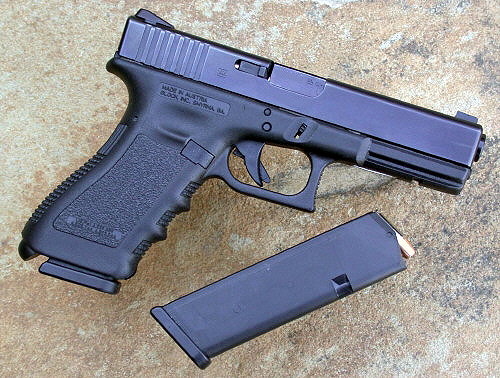
In my experience, the very common Glock 17 is almost always boringly reliable, easy to carry, and easy to maintain. The gun's "safe action" yields an easy to shoot pistol, but one that absolutely demands proper handling. Of the DAO-type automatics, the Glock is internally less complex than most and easier to completely disassemble. Speaking only for myself, I would trust this gun in a fight or for protection but it would not be my first choice for precise shooting at small targets or at long range. Small groups can be had with the Glocks but I find myself having to really work for them compared to other handguns. How important is this? That depends upon the individual shooter. It may be of no concern for the person interested purely in a defensive arm to be used in compressed time frames and in panic situations to protect life and limb.
Conclusion: Not a comprehensive work detailing each and every action available for automatics today, I have tried to at least present a non-emotional look at the more common choices. Which is best overall? That's hard to say. More than just action type, caliber, shooting skills, or caliber enter into the equation. What might seem a clear picture becomes murky when things like police department regulation, personal experience and competence at arms, and plain old personal preferences are considered.
For me, the single-action automatic remains my first choice for carry and I have no problems with it for home defense either. I have used Condition One for so many years that it is just SOP. So that's what I use for home defense, right? Wrong! Not every member of the household is a diehard dedicated shooter. While my wife believes in having firearms for self-defense, she is not interested in the least in recreational shooting. She is safe with firearms but probably wouldn't remember to disengage the thumb safety on a 9mm Hi Power. Her personal "house gun" is a double-action revolver with a light, smooth action that is loaded with 38 Special +P ammunition. She can also shoot either my Glocks or my DAK SIG-Sauer pistols. Both of these handle like her point-and-pull DA revolver. As this is typed, my Glock 17 is but a few feet away. I do not prefer it to my single-actions but find that it more appropriately meets the combined perceived needs of the household.
When in policing and living alone, a cocked-and-locked Hi Power or 1911 was never far away. Whichever was serving as my duty gun also served as my "house gun."
For strictly self-defense considerations, my personal, subjective preferences are:
Single-action
DAK
Selective Double-Action
Glock Safe Action
Conventional Double-Action
For a defense gun and range pistol:
Single-Action
Selective or Conventional Double-Action (tie)
DAK
Glock Safe Action
For strictly a home defense gun seeing at least some practice and range time:
DAK
Conventional Double-Action
Selective Double Action
Glock Safe Action and Single-Action (tie)
My choices may or may not be yours but I hope that the information presented helps in making the decision that is best for you.
One thing that is right for all of us is staying focused on handgun safety. Let's end with a review of the most essential ones.
- All guns are always deemed to be loaded A gun is loaded unless I have personally unloaded it and it has NOT left my possession. If it is or if I have lost sight of it for even a second, it is considered loaded.
- Do not point the gun at anything you are not willing to see destroyed Always keep the gun pointed in as safe a direction as is possible for the circumstances. Make this second nature. Handguns are particularly easy to carelessly point at another. Do not do it. There is no excuse for this intolerable and inexcusable act.
- Do not put your finger on the trigger until ready to fire This one is so simple yet so hard to do when terrified. It requires much discipline to become second nature, but it must. Combine a violation here with No. 2 and the outcome is not going to be a happy one. It could result in loss of life, one's freedom, and regret that lasts until death. It also reflects poorly on the shooting community and plays into the hands of those who would gut the Second Amendment.
- Be sure of your target and what is beyond ******************************************************************************************
Bankers Planned World Wars to Destroy Germany
By Henry Makow Ph.D.
August 3, 2007
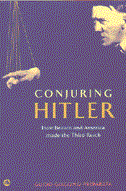
By Henry Makow, Ph.D.
We study history because the secret forces that determined the past are still in charge. The past illuminates the present and the future.
In his book "Conjuring Hitler: How Britain and America Made the Third Reich", (2005) economic historian Guido Preparata demonstrates how the two World Wars essentially were traps designed by London-based central bankers to destroy Germany as a national entity.
As one diplomat said in 1914, "the web was spun and Germany entered it like a great buzzing fly." (24)
Later, the Bank of England created the conditions for Nazism and "devoted herself to supporting financially the Nazis and subsequently arming them to the teeth with the prospect of manipulating them." (xvi)
"This game of Anglo American supremacy came at the cost of approximately 70 million lives (two world wars); a holocaust whose nature is beyond words. Both conflicts were willed and set off by Britain.... there is something far worse than Nazism, and that is the hubris of the Anglo-American fraternities, whose routine is to incite indigenous
monsters to war, and steer the pandemonium to further their imperial aims." (xix)
By "fraternities" Preparata, should be referring to lodges. The Masonic "New World Order" is "British" imperialism repackaged. A small degenerate financial elite based in the City of London has always desired to colonize the world. As we have seen, these Illuminati bankers plan a third world war between political Zionism (i.e. Israel and the US) and Islam (i.e. Iran) designed to destroy both sides.
Germany never represented a threat, nor does Iran. The purpose of these wars is to destroy the nation state, slaughter the best of humanity, demoralize, dehumanize, and profit. The ultimate goal is a veiled world dictatorship by the central bankers.
INSIGHTS
Preparata, who has a Ph.D. in Economic History from Southern Cal and teaches at the University of Washington, is not familiar with the Masonic agenda. But he is honest and smart enough to bare its workings.
For example he says nearly all terrorism is state sponsored. "In general the art of terror entails (the state's) underground promotion of a fictitious grouping: say an 'ethnic army of liberation' or a radical militia...[and involving it in] Sabotage either against the state itself
or against the targeted enemy...In the first case, a variety of prearranged ends all congruent in point of social control and surveillance, is swiftly implemented...the evanescent Bin Laden and his lieutenants are from start to finish an invention of the CIA." (21)
The goal is war for its own sake. In the second half of the Nineteenth Century, the bankers built up Germany to rival England, in order to have a war. When Germany was not destroyed in 1914-1918, they built up the Weimar Republic. Weimar was entirely dependent on financial transfusions from the UK/US. The Wall Street Crash of 1929
partly was contrived to elect Hitler.
The bankers also used their Communist puppets as a "threat" to ensure that Hitler was elected as "a bulwark against Communism."
Meanwhile, "The attitude of the Communists toward Hitler's moderate opponents remained undeviatingly hostile and destructive.... this aided the Nazis." (190)
Preparata is remarkably clear about the mechanics of the Second World War. IG Farben, the company that supplied Nazi Germany with its war machine was part of Standard Oil. In exchange for the world rights for the synthetic oil process (outside of Germany), in 1929 Standard Oil transferred $35 billion in stock to I.G. Farben. The two companies were also linked by patent and cartel agreements.
Here is a partial list of the proportion of Nazi war materiel supplied by I.G. Farben/Standard Oil: Synthetic rubber (100%); dyestuffs (100%); poison gas (95%) explosives (84%); gun powder (70%); aviation gas (46%) not to mention Zyklon B.
Preparata sheds light on many of the murkier aspects of inter-war history: the betrayal of the White Russians by the Allies; the 1922 Rapalo Agreement where the future pugilists Russia and Germany actually trained in Blitzkrieg tactics together; the careers of such shadowy operatives as Alexander Helphand (Parvus), Walter Rathenau, Trebitsch
Lincoln, Hjalmar Schacht, and General Kurt Von Schleicher, who finally tried in vain to stop Hitler.
Preparata reports that Montagu Norman (Governor of the Bank of England ,1920-1944) suffered "sudden fits of melancholy, seizures of despondency so unbearable that his nerves would snap..." He had a tendency to "over dramatize, beguile and bamboozle the whole world." (148)
Unfortunately, Preparata overlooks the most important and most mysterious figure of them all, Max Warburg.
Preparata thinks the Anglo Americans were motivated by a fear that Germany and Russia would unite against them. This was not the real concern. But even if the author doesn't see the big picture, he gets many details right.
CONCLUSION
For some time I've been saying that the Nazis were created by the Illuminati to seduce and destroy Germany. See "Illuminati Used Appeasement to Trick Hitler" and "Illuminati Bankers Hired Hitler to Start World War II"
A relatively small clique with power to create money holds mankind hostage. nfortunately its agenda is to destroy and enslave humanity-using war and education/media as its principal instruments.
Therefore, when it comes to war, we can tune out the rhetoric. All wars are against humanity. They are inherent in the organization of society and in the treason of its leadership. Certainly the next one will be aimed at the United States, in much the same way as Germany. The US already has entered the web like a "great buzzing fly."
************************************************************************************
![]()
British forces failed in Basra, says US official
By Damien McElroy, Foreign Affairs Correspondent
A senior US intelligence official in Baghdad has said British forces lost control of Basra by pulling out troops too quickly.
 | |
The result has been a security vacuum which has allowed the city's religious, tribal and criminal factions battle it out for control of the streets.
"The British have basically been defeated in the south," the intelligence official told the Washington Post.
In a report to be published tomorrow in the influential American newspaper, the official said that a contingent of 500 British troops based at Basra Palace were "surrounded like cowboys and Indians."
Outside the palace walls, fighters allied to the three biggest Shia Muslim groups wage war with impunity.
British commanders are preparing to hand over Basra Palace to the Iraqi army later this month.
After that the 5,500 British soldiers in southern Iraq will all be based at Basra airport, which also houses international consulates and reconstruction workers.
The picture at the airport, which stands outside the city, is scarcely any better with 600 mortar and rocket hits recorded in the past four months.
British officials publicly state the timetable for drawing down troops from a peak of 40,000 during the invasion has been dictated by improvements in the Iraqi security forces.
But an ex-British defence official, now based in Baghdad, told the newspaper that America had criticised London's push to withdraw at the "highest levels."
America "has been very concerned for some time now about a) the lawless situation in Basra and b) the political and military impact of the British pullback."
In his meeting with President George W Bush at Camp David last week, Gordon Brown told the US leader that British troops hoped to hand over responsibility for Basra to Iraqi officials in the next few months.
But the process has been hampered by feuding within the Basra provincial government and with Baghdad.
Fadhilah, the ruling party in Basra, has condemned Prime Minister Nouri al-Maliki's Dawa Party as a reincarnation of Saddam Hussein's Ba'ath regime.
But the city's problems go wider than its dysfunctional politics.
The newspaper quoted from one think tank report that said the legacy of British rule in Basra was: "the systematic misuse of official institutions, political assassinations, tribal vendettas, neighbourhood vigilantism and enforcement of social mores, together with the rise of criminal mafias."
The instability of the area was highlighted by the death of a British soldier in the province last night.
The Ministry of Defence said the soldier, from the 2nd Battalion The Royal Welsh, was killed when he came under fire during an operation in the Al Fursi district of the city last night.
The latest death brings the total number of British service personnel who have died in Iraq since the 2003 invasion to 165.
************************************************************************************ISAIAH CHAPTER 34, VERSE 6
ו חֶרֶב לַיהוָה מָלְאָה דָם, הֻדַּשְׁנָה מֵחֵלֶב, מִדַּם כָּרִים וְעַתּוּדִים, מֵחֵלֶב כִּלְיוֹת אֵילִים: כִּי זֶבַח לַיהוָה בְּבָצְרָה, וְטֶבַח גָּדוֹל בְּאֶרֶץ אֱדוֹם. 6 The sword of the LORD is filled with blood, it is made fat with fatness, with the blood of lambs and goats, with the fat of the kidneys of rams; for the LORD hath a sacrifice in Bozrah, and a great slaughter in the land of Edom.

